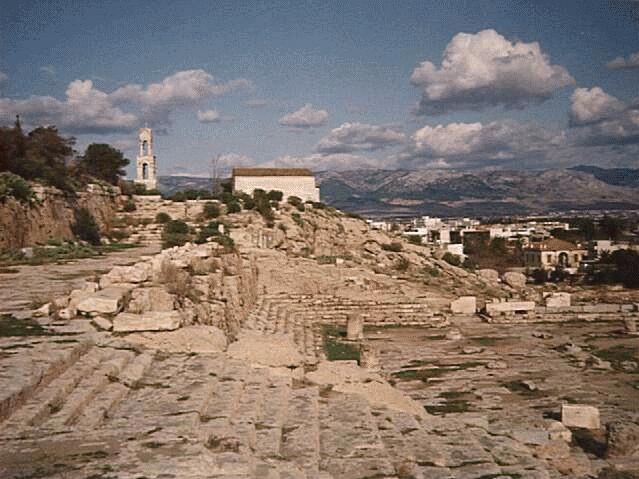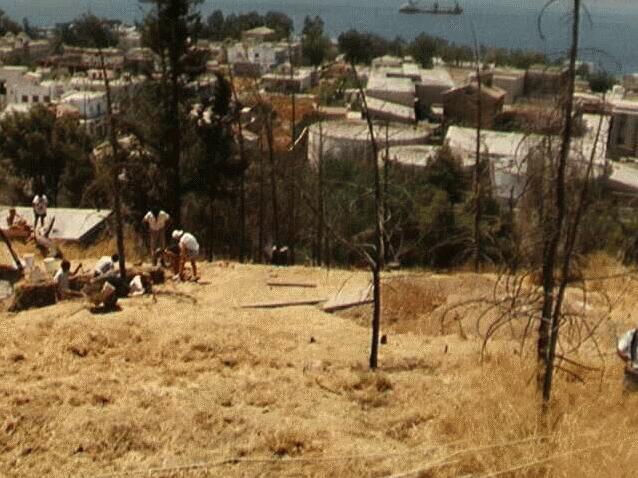DEMETER: THE CULT AT ELEUSIS
MEADOWS & FLOWERS: (symbols of {lost} virginity)
- -PERSEPHONE a hundred-headed narcissus (Hymn to Demeter 8 & 428)
- -EURYDICE meadow, fleeing from the Bee-man ARISTEAS (a death-figure: 'Best man')
- -CREUSA princess of Athens, mother of Ion (Euripides Ion 889): crocus
- -HELEN rhodon ('rose') (Euripides Helen 243 ff.)
- -EUROPA rhodon (Moschos 2. 68-70) Zeus appeared to her, 'breating crocus' (according to Hesiod F 140 Merkelbach)
- -OREITHYIA one of the Hyakinthidai ('daughters of the hyacinth'), grandmother of EUMOLPUS (the first Hierophant at Eleusis) and great-grandmother of KERYX (his son, first Herald at Eleusis) search for the bulbs of some plant (Aristophanes Clouds 187-192), said later to be of the narcissus plant (pseudo-Dioskoreides de materia medica 4. 158)
INITIATIONS:
I. THE LESSER MYSTERIES
: Athenian 'flower-month' Anthesterion (February/March)- 12th Pithoigia 'opening the jars'
- 13th Choes 'wine amphorae'
- 14th Chytrai
held at Agrai, in Athens, on the south east side of the Ilissos stream, just outside the old walls, where there
was a shrine of Demeter (Metroon) and of Artemis. The maiden OREITHYEIA was abducted by BOREAS
('North Wind': Death/cold) and ravished. She had a companion, PHARMAKEIA ('user-of-drugs')
[Plato Phaedrus 229c]
II. THE GREATER MYSTERIES:
Athenian 'bull-running' month Boedromion (Sept./Oct.)On the 13th and 14th Boed., the young aristocratic Athenian EPHEBES (teens engaged in military training)
escorted the 'sacred things' from Eleusis to Athens. They were brought to the ELEUSINION, at the west foot
of the Acropolis. Their arrival was then reported to the priestess of Athena Polias (City-Athena). The first four
days of the festival took place in Athens (15th to 18th):
escorted the 'sacred things' from Eleusis to Athens. They were brought to the ELEUSINION, at the west foot
of the Acropolis. Their arrival was then reported to the priestess of Athena Polias (City-Athena). The first four
days of the festival took place in Athens (15th to 18th):
- 15th Agrimos ('Gathering')
- 16th 'Seaward, Initiates'
- 17th 'Hither the victims'
- 18th Epidauria (at Athens)
- 19th March to Eleusis
- 20th Initiation
- 21st Plemochoiai
The festival was supervised by the Athenian magistrate, the BASILEUS ('King'), with two assistants from the
Athenian Citizen body and a representative of the Clan Eumolpidai and Clan Kerykes. Initiates had to bathe
in the sea and sacrifice a pig to Demeter.
Procession to Eleusis (14 miles) led by statue of Iacchos (Bacchus). Participants wore crowns of myrtle on their
heads and carried bundles of leaves bound with bacchoi (rings).
INITIATION: at night, at Eleusis, in the TELESTERION ('Hall of Initiation'), inside of which was a small building
called the ANAKTORON ('King's house' wanax): sacred things kept in baskets (kistai) were 'shown' by the Hierophant
Athenian Citizen body and a representative of the Clan Eumolpidai and Clan Kerykes. Initiates had to bathe
in the sea and sacrifice a pig to Demeter.
Procession to Eleusis (14 miles) led by statue of Iacchos (Bacchus). Participants wore crowns of myrtle on their
heads and carried bundles of leaves bound with bacchoi (rings).
INITIATION: at night, at Eleusis, in the TELESTERION ('Hall of Initiation'), inside of which was a small building
called the ANAKTORON ('King's house' wanax): sacred things kept in baskets (kistai) were 'shown' by the Hierophant
III. EPOPTEIA ('Beholding')
Held the next year (and optional), for the MYSTAI (initiates of the previous year's ceremony) A fresh-cut wheatstalk was 'shown'.
You can view the Reports of the current excavators of the ancient area of Eleusis (Classics Department, University of Manitoba, Canada). They have a newsletter called Persephone , which you are encouraged to look at. It contains photos of the Telesterion area and of other parts of the site.
The interpretation of the "Homeric Hymn to Demeter" as a ritual myth, giving clues to the Eleusinian Mysteries, has recently been challenged. See the review of Kevin Clinton, Myth and Cult: The Iconography of the Eleusinian Mysteries (Stockholm 1992), by Richard Hamilton (Bryn Mawr College).

